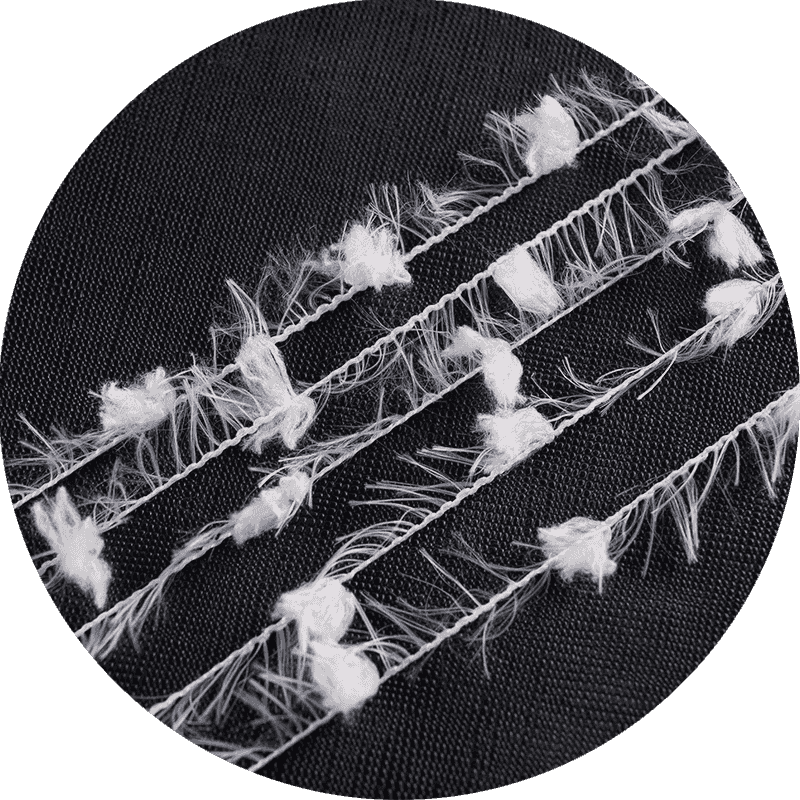In the world of textiles, yarn choice is critical in determining not only the functional properties of a fabric but also its aesthetic appeal and tactile experience. Among the diverse range of specialty yarns, feather yarn stands out for its unique ability to impart softness, volume, and an unmistakable visual elegance to both knitted and woven fabrics. Characterized by its fine, fluffy structure, feather yarn mimics the delicate feel and lightness of feathers, making it highly sought after in fashion, home textiles, and luxury applications. This article explores how feather yarn contributes to the softness, visual texture, and overall appeal of fabrics, examining its structure, manufacturing techniques, and practical applications.
Feather yarn is a type of specialty yarn that integrates fluffy, lightweight fibers with a core or base yarn, creating a unique texture and loft. Typically, the base yarn can be made from natural fibers like cotton, wool, or silk, or synthetic fibers such as polyester or nylon. The addition of short, fine fibers protruding from the main yarn body gives it a feather-like appearance and a soft, tactile quality.
Unlike standard yarns, which maintain a smooth and uniform surface, feather yarn is designed to create surface irregularities. These irregularities are intentional and highly desirable, as they enhance fabric volume, drape, and aesthetic interest. Depending on the manufacturing method, feather yarn can be engineered to have varying lengths of protruding fibers, different densities, and even color effects, offering versatility for designers and manufacturers.
Softness is one of the most immediate and perceptible benefits of feather yarn. Its structure allows the fibers to trap air between the yarn strands, creating a cushiony effect that feels gentle against the skin. This is particularly advantageous in garments such as sweaters, scarves, baby clothing, and luxury knitwear, where comfort is a primary consideration.
The protruding fibers reduce the contact pressure between the skin and the fabric surface, enhancing tactile comfort. Fabrics made from feather yarn tend to feel lighter and fluffier than fabrics made from regular spun yarn, even when the fabric weight is similar. In woven applications, feather yarn can add a subtle pile effect, improving the fabric’s softness and visual depth without the need for additional finishing treatments.
Moreover, feather yarn’s softness does not compromise durability. When blended with strong core fibers, it maintains structural integrity while delivering a luxurious feel, making it suitable for high-end fashion and home textiles that require both elegance and longevity.

Beyond tactile softness, feather yarn significantly enhances the visual and textural appeal of fabrics. The irregular surface created by the protruding fibers produces a rich, three-dimensional texture that is immediately noticeable in both knitted and woven fabrics.
In knitted fabrics, feather yarn adds volume and elasticity, creating fabrics with soft drape and flowing silhouettes. The yarn’s surface fibers scatter light differently than smooth yarns, producing a subtle shimmer and depth that adds visual interest. Designers often use feather yarn in patterns such as fuzzy knits, ribbed textures, or openwork designs, where the yarn’s fluffiness enhances the overall fabric structure and aesthetic.
In woven fabrics, feather yarn introduces surface irregularities that can mimic natural textures like wool fleece, brushed cotton, or even down-like surfaces. This effect is often used in home textiles such as throws, cushion covers, and blankets, where the tactile and visual appeal is critical. The combination of feather yarn with other yarns allows for layered textures, giving designers the flexibility to create fabrics that are both soft to the touch and visually dynamic.
Feather yarn also contributes to improved fabric drape and body. The trapped air and loftiness of the yarn increase the fabric’s apparent volume without adding excessive weight. In garments, this translates into graceful silhouettes, flowing hemlines, and voluminous sleeves. For woven home textiles, it produces plush, inviting surfaces that enhance the comfort and visual warmth of interiors.
The combination of softness and volume creates a perception of luxury and quality. Consumers often associate fluffy textures and gentle hand-feel with premium products, making feather yarn an ideal choice for designers looking to elevate their offerings.
Feather yarn also offers versatility in color and pattern design. Fibers can be dyed before or after the yarn production process, allowing for gradient effects, multi-color blends, or heathered looks. In combination with knitting or weaving techniques, feather yarn can create unique visual patterns such as flecks, stripes, or textured motifs.
The irregular fiber distribution enhances light reflection, which adds subtle highlights to fabrics. This is especially valuable in fashion design, where small visual nuances can distinguish a garment or accessory in a competitive market.
The benefits of feather yarn in softness and aesthetic appeal make it suitable for a wide array of applications:
The adaptability of feather yarn ensures that it can be used in both casual everyday products and premium, designer collections, making it a favorite among textile manufacturers.
While feather yarn enhances softness and aesthetics, proper care is essential to maintain its unique qualities. The protruding fibers may be prone to matting or snagging if not handled carefully. Recommended practices include:
Following these care instructions ensures that the fabric retains its softness, volume, and visual appeal over time.
Feather yarn represents a versatile and innovative solution in textile design, offering a remarkable combination of softness, volume, and visual sophistication. Its unique structure enhances both tactile comfort and aesthetic appeal, making it ideal for knitted and woven fabrics across fashion and home textile industries.
By adding loft, texture, and subtle visual effects, feather yarn transforms ordinary fabrics into luxurious, inviting, and high-value products. From delicate baby garments to premium knitwear and plush home textiles, the use of feather yarn elevates both the consumer experience and the perceived quality of the product. As textile technology advances, feather yarn will continue to be a key material for designers and manufacturers aiming to merge softness, style, and functionality in innovative fabric solutions.